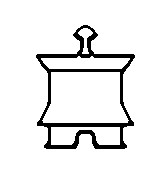Pyxis

The pyxis (pl. pyxides) is a small round box, probably used for storing trinkets, ointments or cosmetics. The type can be traced back to Geometric examples, which are often topped by horses, but the most common black-figure shape seems to have been borrowed from Corinth. In red-figure, pyxides are regularly decorated with scenes of female activity, and the shape is shown in feminine contexts. Contemporary references to vessels of this sort use the word kylichnis, and the term pyxis is found mainly after the fourth century B.C. However, its connection with the Greek pyxos - boxwood, may reveal something about the shape's material origins, and examples of the shape can be found in other media, such as stone

Type A : The type A pyxis is a vase with high concave walls and a flattened cover with a knob serving as a handle. It sometimes has a low foot-disc or it may stand on three notched low feet. This shape was the most common and was borrowed from the covered boxes of Corinth. It is popular throughout the sixth century to the fifth century B.C., regularly decorated with various scenes of women.

Type B : A pyxis with a low foot, low conave sides, and a dome-shaped lid. This shape was especially popular in Attica in the fifth and fourth centuries B.C.

Type C : A pyxis characterized by its low concave walls which have a wider flaring lip and base. It rests on a low, slightly recessed foot, and is covered with a dome-shaped lid. This type of pyxis enjoys its greatest popularity from the late fifth century to the fourth century.

Type D : This shape of pyxis is characterized by its cylindrical walls, and its flat handless lid. Round, mostly handleless boxes were used by women to contain toilet articles; many have been found containing the remains of rouge, cosmetics and other treasures.

The Nikosthenic type is a lidded vase with a flaring body, standing on a low stemmed foot. A high conical lid topped by a knob covers the vase. This particular pyxis is named in modern times for the potter, Nikosthenes, who introduced this type.





